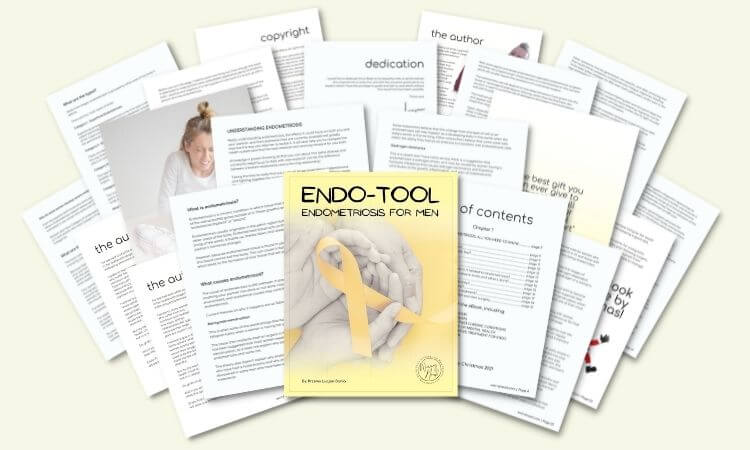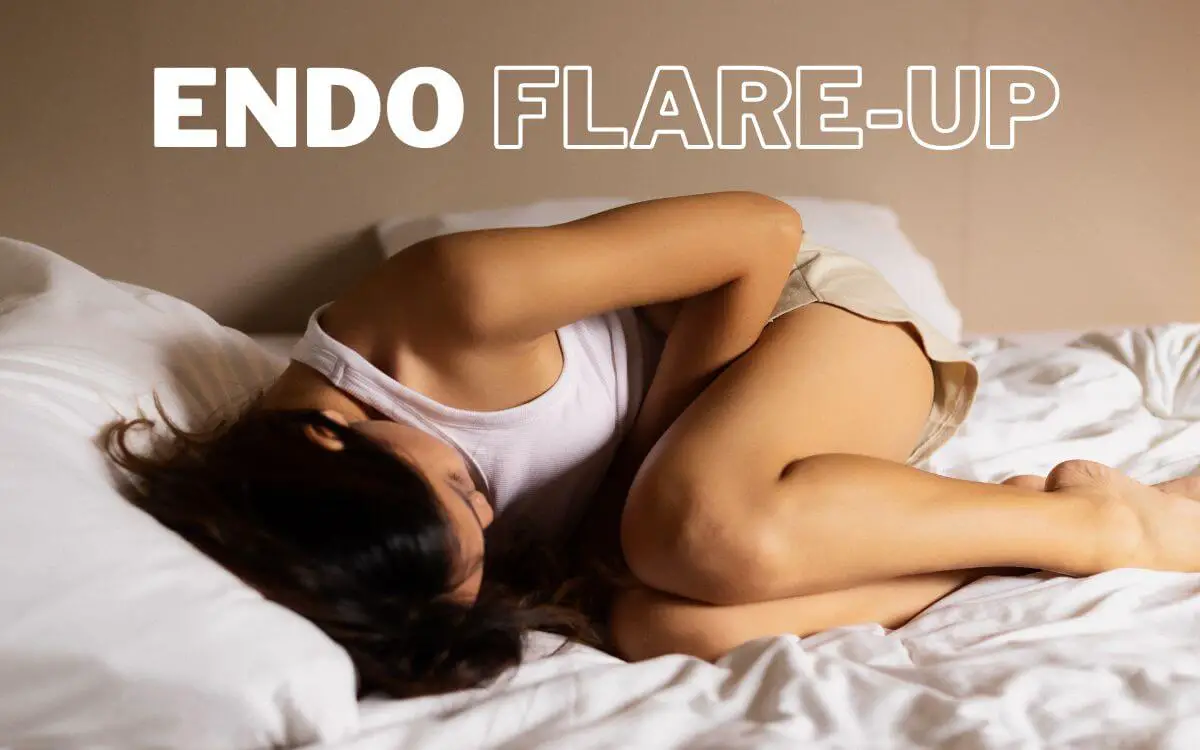Endometriosis flare up.
Endometriosis is a painful disorder that affects millions of women worldwide. It is a chronic condition that occurs when tissue similar to the lining of the uterus grows outside of the uterus, leading to inflammation and scarring.
Women with endometriosis experience a wide range of symptoms, including painful periods, pain in the pelvic area, and a painful bowel movement, among others.
An endometriosis flare-up refers to a sudden and intense increase in symptoms associated with endometriosis, such as pelvic pain, heavy periods, and fatigue. These flare-ups can be triggered by various factors, including hormonal fluctuations and stress.
While the severity of endometriosis can vary from person to person, many women experience endometriosis flare-up symptoms that cause increased pain and discomfort. In this blog post, we will discuss the symptoms, triggers, and treatment options for endometriosis flare-ups.
Understanding endometriosis symptoms.
Endometriosis symptoms can vary depending on the person and the severity of their condition. Some common symptoms include:
- Menstrual pain. Women with endo often experience severe menstrual pain that can last for several days.
- Pelvic pain. Endometriosis can cause chronic pain in the pelvic region, which can occur at any time during the menstrual cycle.
- Painful bowel movement. Women with endo may experience a painful bowel movement, especially during their menstrual period.
- Abdominal pain. Endometriosis can cause pain in the lower abdominal area.
- Other symptoms. Endometriosis can also cause fatigue, bloating, and nausea.
Understanding an endometriosis flare-up.
Endometriosis flare-ups are a common symptom for many women with the condition. They occur when the endometrial tissue becomes inflamed and irritated, causing an increase in pain levels. Flare-ups can be triggered by a variety of factors, including hormonal changes, stress, and certain foods.
If you want to learn more about endometriosis, I wrote an “Endo-Tool, Endometriosis for Men” e-Book.
You can get the 1st Chapter of the e-Book for FREE, and if you like it, you’ll get a Whopping 33% Discount on the Whole Book, plus discounts on other helpful tools. You have nothing to lose but a lot to gain!
The first chapter alone contains all the comprehensive medical knowledge about endometriosis, including:
- What is endometriosis?
- What are the symptoms?
- What causes endometriosis?
- What does endometriosis look like?
- What are the stages?
- What are the types?
- What is adenomyosis and how is it related to endometriosis?
- Why do some women develop severe endo and others don’t?
- Does endometriosis cause infertility?
- How is endometriosis diagnosed?
- Do types and stages affect the treatment?
- Recurrence of endometriosis after excision surgery.
FREE Chapter of “Endo-Tool”
Endometriosis e-Book for Men

What are the common triggers for endometriosis flare?
The most common triggers for an endometriosis flare-up can be:
- hormonal changes
- stress
- certain foods
- lack of sleep
- wearing tight clothes
- different triggers
Hormonal changes, particularly during the menstrual cycle, can trigger endometriosis pain. When it comes to high-stress levels, they can also cause endometriosis flare.
Some women find that eating certain foods, such as red meat or inflammatory foods can trigger them, along with poor sleep, and even tight clothes, because wearing tight clothes can put pressure on the abdomen and trigger an endometriosis flare-up.
In addition to all of the above, endo flare-ups can be triggered by a variety of factors, and what triggers a flare-up can vary from person to person.
What are the symptoms of endo flare-ups?
Symptoms of endo flare-ups can be similar to the symptoms of endometriosis in general. However, during a flare-up, the pain levels may be more severe.
Some common symptoms of endometriosis flareups include:
- Increased pain. Women may experience an increase in pain volume during a flare-up. These flare-ups can cause severe pain in the lower abdomen and pelvis, which may be accompanied by other symptoms such as bloating, nausea, and fatigue.
- Endo-belly. Endo-belly is a term used to describe the bloating and discomfort that some women experience during an endo flare.
- More painful periods. Menstrual pain may be more severe during a flare-up. Endo flare-ups often coincide with the menstrual period and may cause more severe pain during this time.
- Other symptoms. Endometriosis flares may also cause other, less-known symptoms, such as pain during bowel movement, painful urination, and pain during sexual intercourse, although the latter is slightly more common than the former.
How do you treat an endometriosis flare-up?
There are several (common) treatments for an endometriosis flare-up, they include painkillers, hormones, and pain management techniques. It is important to work with a healthcare provider to develop treatment plans that work best for each person.
Pain medications include nonsteroidal anti-inflammatory drugs (NSAIDs), which can help manage the pain associated with flares.
When it comes to hormones, hormone therapy is another option for managing endometriosis pain.
A hormonal birth control pill can help regulate the menstrual cycle and reduce the growth of endometrial tissue. Other hormone therapies, such as gonadotropin-releasing hormone (GnRH) agonists, can help reduce estrogen levels, which can help shrink endometrial tissue.
For some women with endometriosis (in my opinion, the best), pain relief may be achieved through surgery to remove the endometrial tissue. Surgery is not always a viable option for everyone as there are a few types, plus, even after surgery, there is a risk of endometriosis returning.
Other endometriosis pain relief options may include physical therapy, acupuncture, or nerve blocks. This is a holistic approach to treatment, which doesn’t give nasty side effects.
In addition to all of the above treatments, there are also lifestyle changes that can help manage endometriosis flares.
Treating endometriosis can be done in a holistic way and includes reducing stress levels, getting enough sleep, and following an anti-inflammatory diet.

How do you manage endometriosis symptoms?
Managing endo pain can be challenging, but there are steps that women with endo can take to help reduce the frequency and severity of flares.
I give you some ways to manage them:
- One of the first steps in managing endo flare-ups is to identify triggers. This may include some foods, stress, lack of sleep, or a hormonal change.
- Endometriosis is an inflammatory condition, and reducing inflammation in the body may help reduce the frequency and severity of endo flares. This may involve following an anti-inflammatory diet, reducing consumption of inflammatory foods like meat (red), caffeine, and alcohol, and incorporating anti-inflammatory supplements like omega-3 fatty acids.
- Pain medication is a crucial part of managing endo flares. Women with endo may benefit from taking pain medications, using a heating pad or hot water bottle, or trying other pain relief methods like physical therapy or acupuncture.
- Hormone therapy may also be helpful in managing endo pain. Women with endo may benefit from taking birth control pills or other hormone therapies that regulate the menstrual cycle and reduce estrogen levels.
- In some cases, surgery may be necessary to manage endometriosis pain. This may involve removing endometrial tissue or other affected reproductive organs or performing a hysterectomy.
- Stress can exacerbate symptoms and trigger a flare-up. Managing stress through practices like yoga, meditation, or therapy can help reduce the frequency and severity of endometriosis pain.
- Lack of sleep can also exacerbate endo symptoms and trigger symptoms. Getting enough sleep is crucial for managing endometriosis, and women with endometriosis may benefit from developing good sleep hygiene practices.
- Wearing tight clothing can put pressure on the abdomen and exacerbate endometriosis pain. Opt for looser clothing or maternity wear during flares.
- A high-stress level can increase inflammation and exacerbate endometriosis pain. Practicing stress management techniques such as meditation, yoga, deep breathing, or therapy can help reduce stress and improve symptoms.
- It is important to recognize the symptoms of endometriosis flare up to manage it properly. Common symptoms include severe abdominal or pelvic pain, painful bowel movements or urination, heavy bleeding, fatigue, and bloating.
- An endometriosis flare can occur when the endometrial tissue lining the reproductive organ and pelvic cavity becomes inflamed, causing pain and discomfort. Pain flares can be triggered by hormonal changes, some foods, stress, lack of sleep, and other health issues.
- Treatment for endometriosis flares may include pain management, hormone therapies, or surgery in more severe cases. It is important to work closely with healthcare providers to develop a personalized treatment plan.
- The Endometriosis Foundation is a nonprofit organization dedicated to increasing awareness and funding for endometriosis research and education. They offer resources and support for individuals with endometriosis and their families.
- Any hormonal change during the menstrual cycle can trigger endometriosis flares. Birth control pills or hormone therapies may help regulate hormones and reduce symptoms.
- Following a diet that is anti-inflammatory, which focuses on whole, unprocessed foods and reduces the consumption of food that brings inflammation like red meat, caffeine, and alcohol, may help reduce inflammation and improve endometriosis flares.
- Endometriosis is influenced by levels of estrogen, and high levels of estrogen can contribute to endometrial tissue growth and inflammation. Hormone therapies or other treatments may help regulate levels of estrogen.
- Consuming caffeine and alcohol can exacerbate endometriosis flare by increasing inflammation and disrupting sleep patterns. Limiting or avoiding these substances may improve an endo symptom.
- Endometriosis is thought to be related to immune system dysfunction, which can contribute to inflammation and pain. Working with healthcare providers to optimize immune system function may help manage pain.
- It is important to work closely with a healthcare provider who specializes in endometriosis to develop a personalized treatment plan and manage pain effectively.
- Consuming red meat has been linked to increased inflammation, which can exacerbate endometriosis pain. Reducing the consumption of meat or avoiding it altogether may improve each symptom.
- Common symptoms of endometriosis include tummy pain in the pelvic area, painful bowel movements or urination, heavy bleeding, fatigue, and bloating.
- Working with a physical therapist who specializes in pelvis pain may help manage each endometriosis symptom by improving pelvic floor muscle function and reducing pain.
- Inflammation can contribute to endometriosis flares and an increase in pain volume. Avoiding inflammatory food, practicing stress management techniques, and working with a healthcare provider to optimize immunity function may help reduce inflammation.
- Endometriosis is one of many chronic conditions that can cause ongoing pain and discomfort. Managing chronic conditions often requires a multidisciplinary approach and close collaboration with healthcare providers.

Wrapping things up.
My wife has severe endometriosis, she has stage 4 deep infiltrating endo. On top of that, she was also diagnosed with fibromyalgia disorder, and 31% of women with endo also develop fibro.
Treatment and management of this chronic condition when it is advanced endometriosis can be complex. The endometriosis foundation that I mentioned earlier helps many women take control of their endo, but what any endo website lacks is a bit more focus on the partners of women who suffer from this disease.
This medical condition varies from person to person, it brings a higher risk of infertility, cancer, and even suicide. Unfortunately, the latter is rarely spoken of.
And this is where the partner’s support is crucial. Without us, especially male partners, our women suffer and go through these awful things alone.
Many men don’t understand endometriosis. But it doesn’t have to be that way. Men should educate themselves about endometriosis in order to ease their own struggles too. Because not only do the women who are affected by this chronic illness suffer, we suffer too.
This is why I wrote “Endo-Tool”. My book already helped many guys (and couples) understand the male perspective on the matter.
FREE Chapter of “Endo-Tool”
Endometriosis e-Book for Men

So grab a FREE copy of the first chapter that contains all the comprehensive medical knowledge, and if you like it, dive into the rest of the book by buying it at a 33% discount.
Check it out!


About Me
Hi, I’m Lucjan! The reason why I decided to create this blog was my beautiful wife, who experienced a lot of pain in life, but also the lack of information about endometriosis and fibromyalgia for men…
